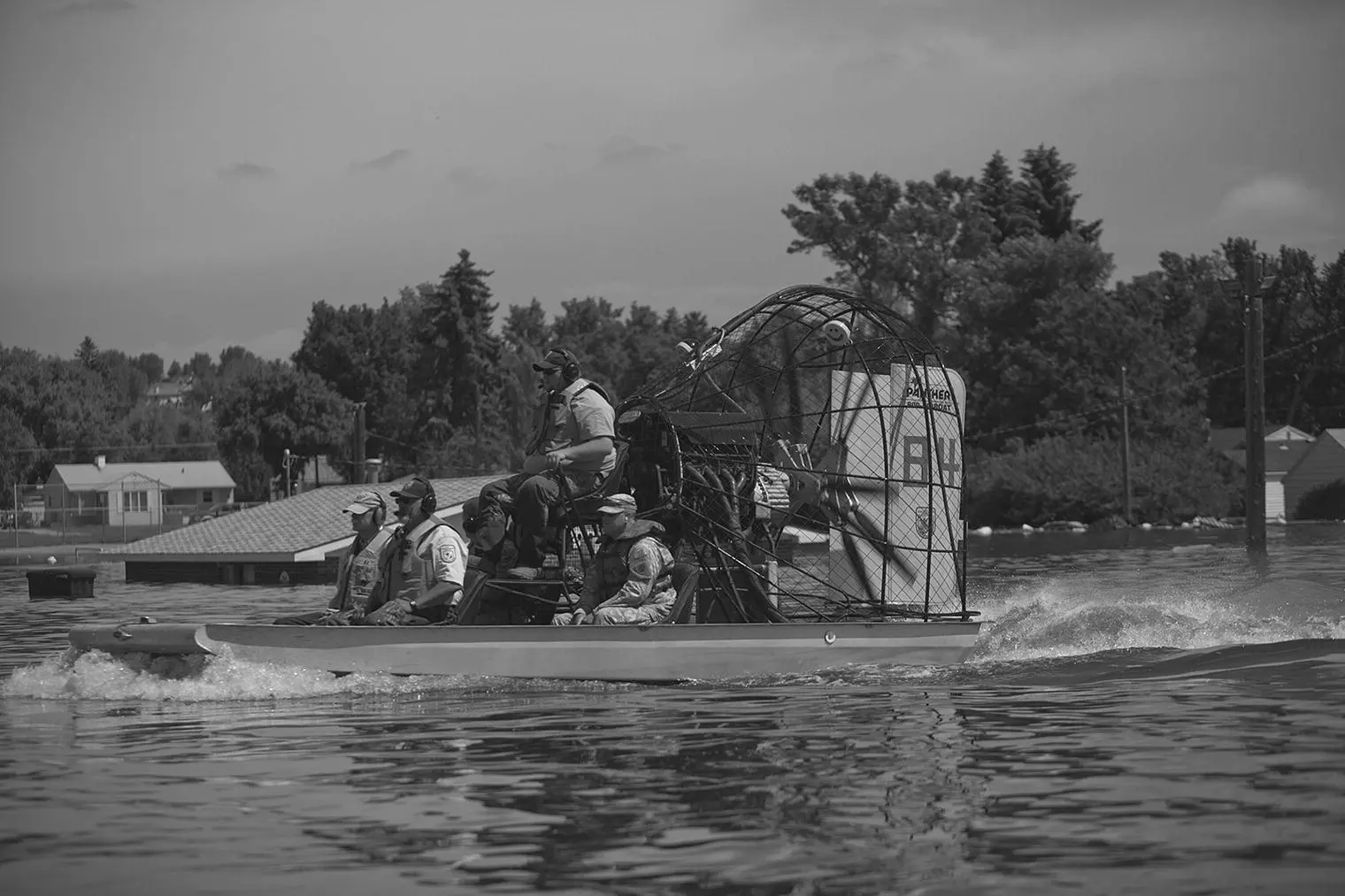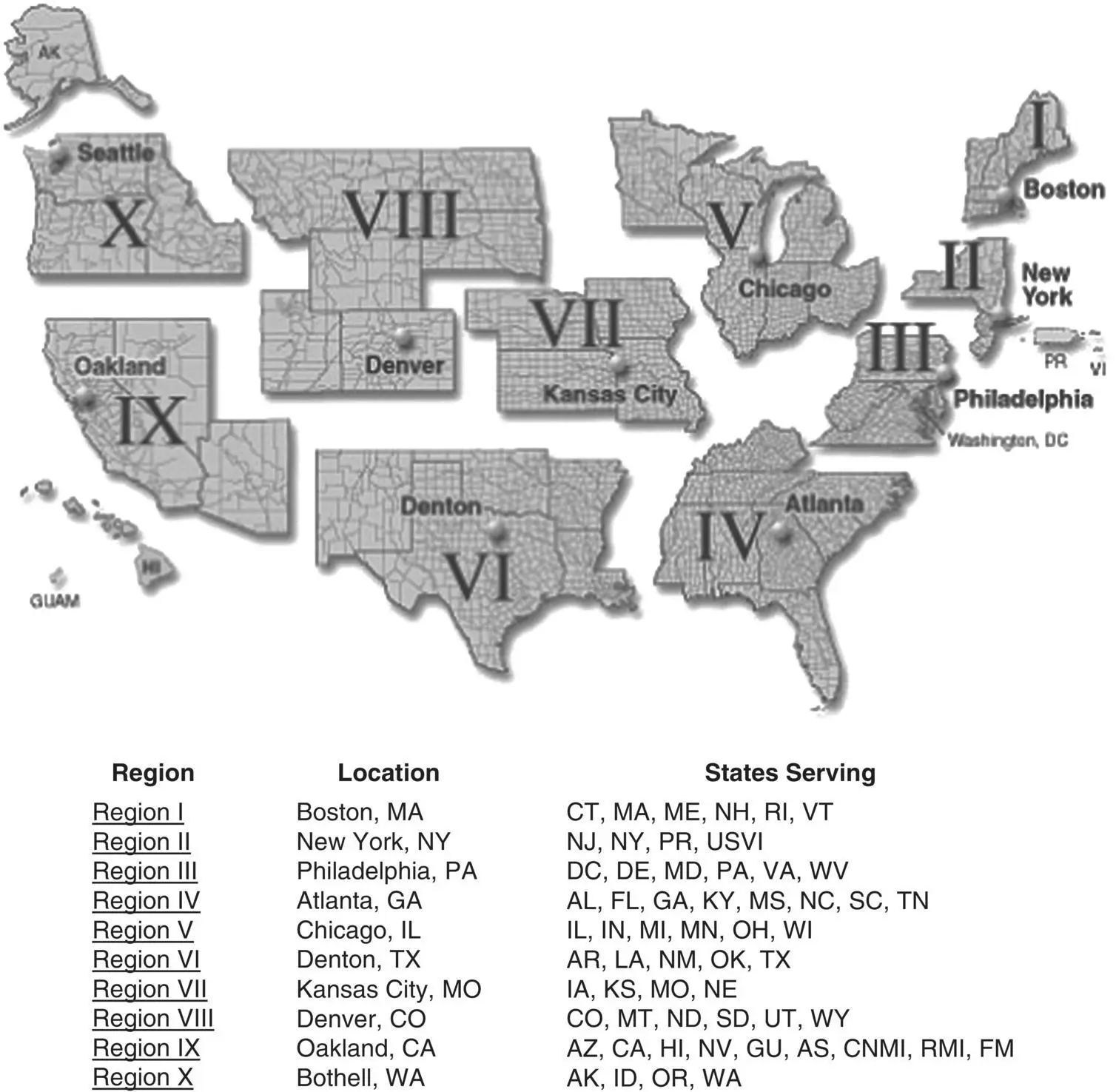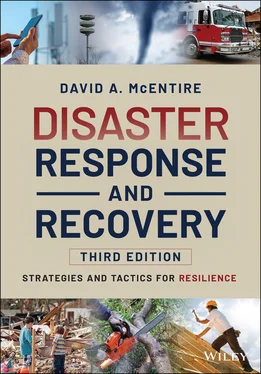David A. McEntire - Disaster Response and Recovery
Здесь есть возможность читать онлайн «David A. McEntire - Disaster Response and Recovery» — ознакомительный отрывок электронной книги совершенно бесплатно, а после прочтения отрывка купить полную версию. В некоторых случаях можно слушать аудио, скачать через торрент в формате fb2 и присутствует краткое содержание. Жанр: unrecognised, на английском языке. Описание произведения, (предисловие) а так же отзывы посетителей доступны на портале библиотеки ЛибКат.
- Название:Disaster Response and Recovery
- Автор:
- Жанр:
- Год:неизвестен
- ISBN:нет данных
- Рейтинг книги:5 / 5. Голосов: 1
-
Избранное:Добавить в избранное
- Отзывы:
-
Ваша оценка:
- 100
- 1
- 2
- 3
- 4
- 5
Disaster Response and Recovery: краткое содержание, описание и аннотация
Предлагаем к чтению аннотацию, описание, краткое содержание или предисловие (зависит от того, что написал сам автор книги «Disaster Response and Recovery»). Если вы не нашли необходимую информацию о книге — напишите в комментариях, мы постараемся отыскать её.
The new edition of the standard textbook in the field, updated with new studies and practical guidelines for reacting to the complexities of today’s disasters Disaster Response and Recovery: Strategies and Tactics for Resilience
Disaster Response and Recovery: Strategies and Tactics for Resilience, Third Edition
Disaster Response and Recovery — читать онлайн ознакомительный отрывок
Ниже представлен текст книги, разбитый по страницам. Система сохранения места последней прочитанной страницы, позволяет с удобством читать онлайн бесплатно книгу «Disaster Response and Recovery», без необходимости каждый раз заново искать на чём Вы остановились. Поставьте закладку, и сможете в любой момент перейти на страницу, на которой закончили чтение.
Интервал:
Закладка:
Much like a mayor or county judge (or parish president in Louisiana), the governor declares emergencies and disasters on behalf of the state (Ferro, Henry and MacLellan 2010). If the state is overwhelmed by the impact, the governor may seek internal or external assistance. This may include calling up the National Guard, which is a reserve military unit operated under the direction of the governor in each state (Stuhltrager 2006). Such a civilian force may assist law enforcement personnel, conduct search and rescue operations, remove debris or provide other types of support as required. The governor may also request relief from other states or the federal government. If the resources within the state prove insufficient, the governor may seek help from other states. For instance, Oklahoma turned to Iowa for help after the May 2013 tornados, because its leaders saw that Iowa had provided a great deal of assistance to aid Louisiana after Hurricane Katrina. Upon the governor’s request, the Emergency Management Assistance Compact(EMAC) can also be activated (Kapucu, Augustin and Garayev 2009). This is like a local mutual aid agreement, but it is operated through states instead. If requested, personnel, equipment and commodities can be sent from EMAC members to a state and communities that are in need. EMAC is operated under the National Association of Emergency Managers, which is an emergency management organization for governors and others affiliated with state emergency management agencies. If the resources of neighboring states or EMAC are insufficient, the governor may also request assistance of the federal government ( Figure 2‐3).

Figure 2‐3 Many entities will work together to respond to disasters. In this picture, personnel from the National Guard and U.S. Department of Wildlife are traveling in a flooded area in Minot, ND, to check on status of telephone towers and power stations. Andrea Booher/FEMA.
2.1.4 Federal Government
The federal governmentis the national political unit that has the highest authority in the United States. The federal government includes political leaders and various agencies and departments that fulfill important disaster roles (Olshansky and Johnson 2015). As mentioned, if local and state jurisdictions are unable to cope with a large disaster, the president of the United States may declare a federal disaster and provide national resources to local and state governments. This occurs through the Department of Homeland Security (DHS) and the Federal Emergency Management Agency (FEMA). These are the specific units of the federal government that are most heavily involved in response and recovery operations when disasters occur.
DHS was created after the September 11, 2001, terrorist attacks. It includes 22 federal agencies and now has over 240,000 employees. DHS is primarily responsible for various security measures in the nation, and it is organized with a Secretary; a Management Directorate; a Science and Technology Directorate; an Office of Strategy, Policy and Plans; and many other offices that deal with legislative affairs, legal issues, public affairs, etc. One of the central goals of DHS is to prevent terrorist attacks on American soil. It therefore relies heavily upon agencies such as Immigration and Customs Enforcement, the Transportation Security Administration and the U.S. Coast Guard.
If a terrorist attack or a disaster occurs, DHS will work closely with FEMA since this agency has a primary responsibility to assist local and state governments under such conditions (Kreiser, Mullins and Nagal 2018). FEMA was created in 1979 by President Jimmy Carter to coordinate the emergency management activities of the government. FEMA has a national office in Washington, DC, that works closely with 10 regional offices scattered around the nation ( Figure 2‐4). FEMA also has many functional divisions to promote mitigation and planning programs as well as other units that address response and recovery activities. FEMA likewise operates Incident Management Assistance Teams (IMAT) that are deployed immediately before or after a disaster to provide protective measures or assess what further resources will be needed. Among other things, FEMA supports large‐scale search and rescue operations, reimburses local government for certain emergency operations, facilitates debris removal, and provides people with funds for rebuilding. FEMA coordinates with many partners involved in two national plans: the National Response Framework and the National Disaster Recovery Framework.

Figure 2‐4 FEMA has 10 regional offices around the United States.
Source: FEMA.
For Example
General Governmental Responsibilities
The number of government entities involved in disasters can be quite overwhelming and operations can be fairly complex. But the government is best understood by simplifying roles and responsibilities into three general areas. The federal government often provides financial assistance and other necessary resources to support state and local governments. The state government manages federal funds and oversees local government response and recovery functions. City and county governments implement required operations to care for victims and facilitate recovery.
The National Response Frameworkis a planning document that describes what the government will do in catastrophic disasters. It deals with the immediate needs made evident by a disaster. The National Disaster Recovery Framework, in contrast, is a guide to enable effective long‐term rebuilding in disaster‐stricken areas. This guideline provides those involved in disaster recovery with a flexible structure to restore affected communities. Some of the organizations involved in these plans take on primary responsibilities, while others perform support functions. Several of these departments and agencies are listed in Table 2‐1.
Table 2‐1 Federal Departments and Their Role in a Disaster
| Department/agency | Disaster functions |
|---|---|
| U.S. Department of Agriculture (USDA) | Suppresses rural and urban fires |
| U.S. Department of Commerce (DOC) | Provides information and assists with planning, resource support, communications, and hazardous material incidents |
| U.S. Department of Defense (DOD) | Assists with public works and engineering, flood control, transportation, urban search and rescue, firefighting, mass care, and health and medical services. The DOD may also become involved in the detection and response to hazardous material spills and weapons of mass destruction |
| U.S. Department of Education (DOED) | Collects, processes, and disseminates critical information |
| U.S. Department of Energy (DOE) | Restores energy systems and reacts to nuclear power plant emergencies |
| U.S. Department of Health and Human Services (HHS) | Supplements local and state public health and medical operations Provides or reestablishes temporary and permanent housing |
| U.S. Department of Housing and Urban Development (HUD) | Provides or reestablishes temporary and permanent housing |
| U.S. Department of the Interior (DOI) | Supports with information and planning, emergency, communications, firefighting, and hazardous material functions |
| U.S. Department of Justice (DOJ) | Participates in information and planning, urban search and rescue, health and medical services, and hazardous material issues. Also ensures that all laws pertaining to disaster assistance are followed |
| U.S. Department of Labor (DOL) | Contributes to public works, engineering, resource support, urban search and rescue, and hazardous material areas |
| U.S. Department of State (DOS) | Takes part in transpiration, energy, and hazardous material services |
| U.S. Department of Transportation (DOT) | Fulfills transportation, information and planning, energy, hazardous material duties after a disaster |
| U.S. Department of Treasury (TREAS) | Funds long‐term recovery projects and mitigation measures |
| U.S. Department of Veterans Affairs (VA) | Seeks assistance for veteran needs after a disaster as well as mass care and health and medical services |
| U.S. Environmental Protection Agency (EPA) | Responds to and cleans up hazardous material spills and also works in firefighting, health and medical services |
| National Communications System | Facilitates communications after a disaster |
| General Services Administration (GSA) | Aids in logistical activities such as transportation, information and planning, mass care, and food distribution roles |
| National Aeronautics and Space Administration (NASA) | Completes urban search and rescue and other functions in reference to satellites and remote sensing |
| Nuclear Regulatory Commission (NRC) | Shares expertise in energy and hazardous material disasters involving nuclear plants |
| Office of Planning and Management (OPM) | Advances logistical and resource support to all other federal agencies involved in disaster response or recovery |
| Small Business Administration (SBA) | Offers financial assistance to individuals and businesses affected by disasters |
| Social Security Administration (SSA) | Supplies mass care, housing, and human services needs |
| Tennessee Valley Authority (TVA) | Makes available transportation, public works, engineering, and energy services |
| US Agency for International Development (USAID) | Supplies urban search and rescue resources and disaster relief |
| U.S. Postal Service (USPS) | Imparts transportation support |
There are many other agencies and individuals that deal with disasters and emergency management besides those listed in the National Response and National Disaster Recovery Frameworks. Some agencies explore the causes and consequences of disasters, while others concentrate attention on specific types of events. For instance, the Federal Aviation Administration (FAA) controls flight traffic before and after aviation accidents occur. The National Transportation and Safety Board (NTSB) investigates transportation accidents such as plane crashes. In fall 2001, a plane crashed in a residential neighborhood in New York. The NTSB traveled to the scene and determined that the accident was caused by turbulence. The Occupational Safety and Health Agency (OSHA) also probes the causes of accidents, but this organization looks more closely at injuries that result in the workplace. Another organization, the Chemical Safety Board, determines the source of industrial explosions that result from safety violations. The Bureau of Alcohol, Tobacco and Firearms (ATF) and Federal Bureau of Investigation (FBI) are additional federal agencies that are involved in investigation. After the bombing of the Alfred P. Murrah Federal Building in Oklahoma in 1995, the ATF and FBI were on the scene to determine what happened and decipher if it was an act of terrorism. The ATF and FBI also pursue and capture those who have violated laws relating to the possession of explosives and others who are considered suspected terrorists.
Читать дальшеИнтервал:
Закладка:
Похожие книги на «Disaster Response and Recovery»
Представляем Вашему вниманию похожие книги на «Disaster Response and Recovery» списком для выбора. Мы отобрали схожую по названию и смыслу литературу в надежде предоставить читателям больше вариантов отыскать новые, интересные, ещё непрочитанные произведения.
Обсуждение, отзывы о книге «Disaster Response and Recovery» и просто собственные мнения читателей. Оставьте ваши комментарии, напишите, что Вы думаете о произведении, его смысле или главных героях. Укажите что конкретно понравилось, а что нет, и почему Вы так считаете.












